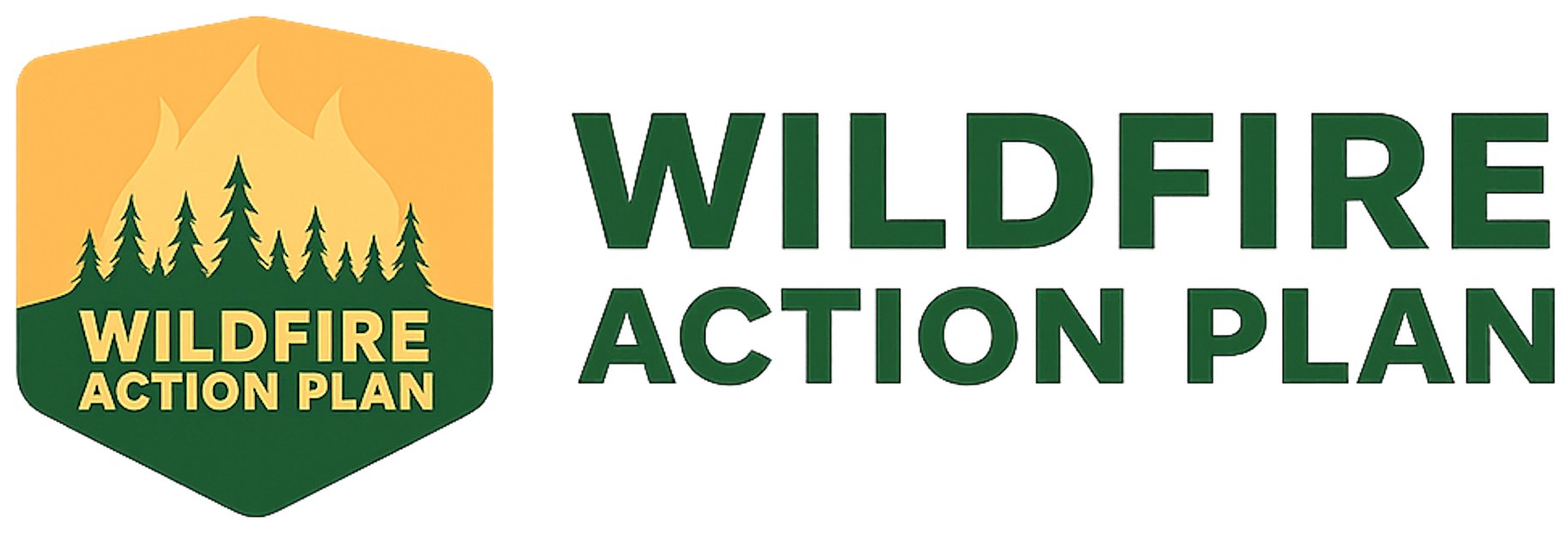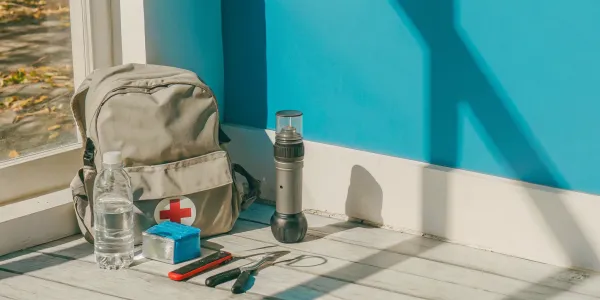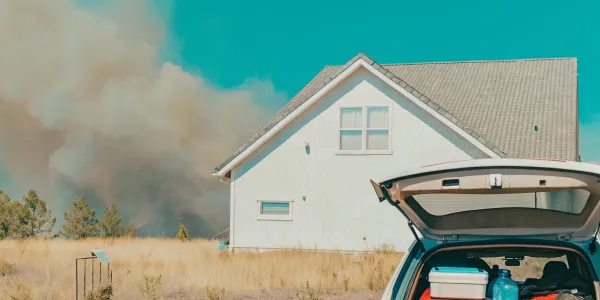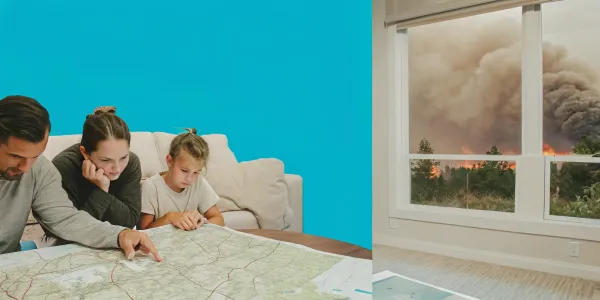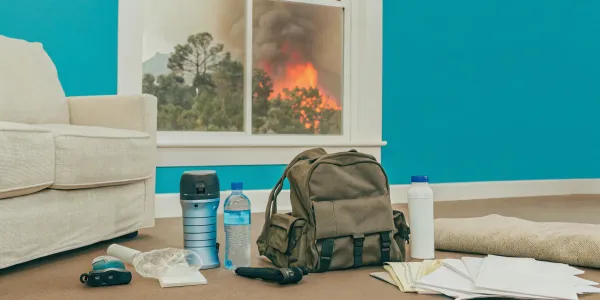Build a Wildfire Emergency Kit at Home: The Ultimate Guide
Learn how to build a wildfire emergency kit at home with practical tips, essential supplies, and storage advice to keep your family safe during an evacuation.
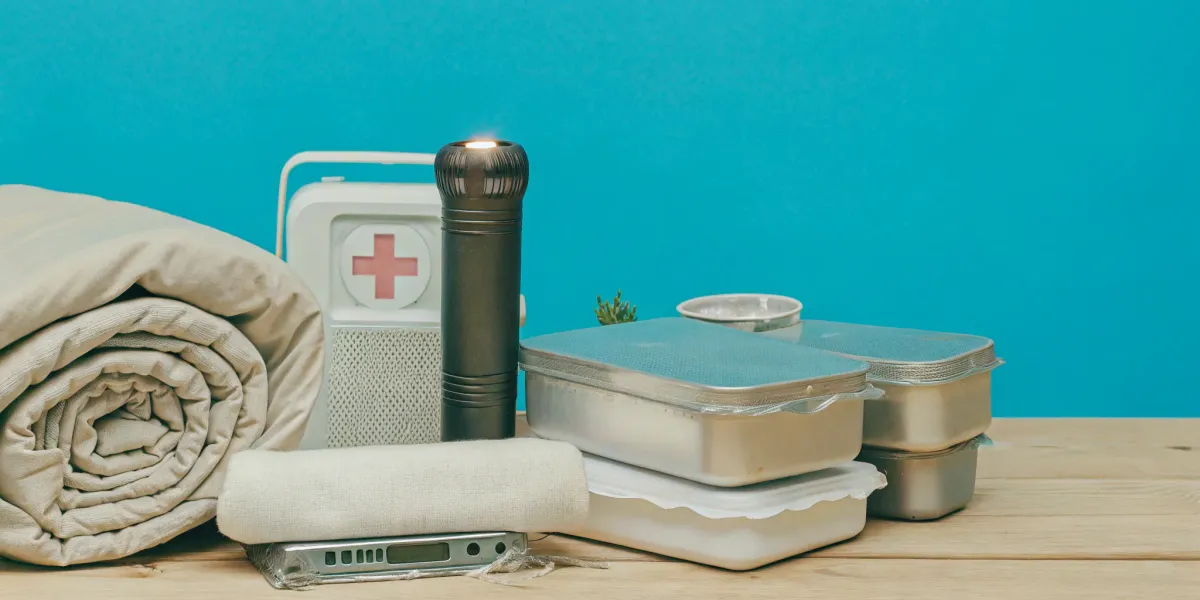
The home insurance crisis in states like California has left many homeowners feeling frustrated and powerless. If you’ve received a non-renewal notice or are struggling with soaring premiums, you’re looking for concrete ways to reduce your risk profile. While home hardening is critical, overall preparedness sends a powerful signal to insurers that you are a responsible homeowner. More importantly, it protects your most valuable assets. A key part of this strategy is to build a wildfire emergency kit at home that includes not just survival supplies, but also copies of your essential financial documents. This simple step ensures that if the worst happens, you have everything you need to start the recovery and claims process smoothly, protecting both your family and your finances.
Key Takeaways
- Customize Your Kit for Your Real Needs: A generic checklist is only a starting point. A truly effective kit is personalized for every member of your household, including pets, and contains at least a seven-day supply of all essential medications.
- Make Your Kit Truly Grab-and-Go: A kit is only useful if you can find and carry it. Store your supplies in an easy-to-reach spot near an exit, keep a separate kit in your car, and make sure everyone in the family knows the plan.
- Don't Pack It and Forget It: Your kit needs regular maintenance. Set a calendar reminder to review supplies every six months—rotate food and water, update documents and medications, and test your gear to ensure it’s all ready when you need it.
Why Every Homeowner Needs a Wildfire Kit
If you live in a wildfire-prone area, an emergency kit isn’t just a good idea—it’s an essential tool for your family’s safety. When evacuation orders come, there’s no time to search for flashlights or gather important papers. Having a well-stocked kit ready means you can focus on one thing: getting to safety. It’s about taking control before a crisis hits, turning anxiety into action, and giving yourself the resources to handle the first critical hours and days of an emergency. Think of it as your family’s grab-and-go insurance policy for peace of mind.
What's Your Real Wildfire Risk?
Your emergency kit should reflect the reality of where you live. A generic checklist is a starting point, but truly effective preparation begins when you understand your local wildfire risk. The specific threats to your home—whether from flying embers in a dense neighborhood or a fast-moving fire in a rural canyon—should inform what you pack. Knowing your risk helps you customize your kit with the right gear, from N95 masks for heavy smoke to extra water if you live far from services. This isn't about dwelling on worst-case scenarios; it's about making a clear-eyed assessment so you can prepare intelligently and effectively for what’s most likely to happen.
How Being Prepared Affects Your Home Insurance
While an insurer may not ask if you have a go-bag, your overall preparedness sends a powerful signal. Taking proactive steps is part of a larger strategy to protect your property and reduce your risk profile. Some insurance carriers may even offer discounts for homeowners who demonstrate they are actively preparing for disasters. More importantly, a well-organized kit should contain copies of your critical financial documents: insurance policies, home inventory lists, deeds, and bank records. Having these on hand can make the process of filing a claim and starting your recovery infinitely smoother. It’s a practical step that protects both your family and your finances.
The Peace of Mind That Comes with a Plan
An evacuation order can trigger a wave of panic. In that chaos, a pre-packed emergency kit is your anchor. Knowing you have food, water, medications, and important documents ready to go allows you to act decisively instead of scrambling. According to disaster preparedness experts at Ready.gov, being self-sufficient for several days can significantly reduce stress during an emergency. Your kit is more than just a bag of supplies; it’s the physical part of your family’s evacuation plan. Building it is a tangible action you can take right now to protect your loved ones, giving you the confidence that you’re ready for whatever comes next.
What to Pack in Your Wildfire Go-Bag
When an evacuation order comes, you won’t have time to think. You’ll need to grab your essentials and go. That’s why having a pre-packed “Go-Bag” for every member of your household is one of the most important steps you can take. This isn’t just a bag; it’s your lifeline, containing everything you need to survive for several days if you can’t return home.
Think of it as your personal emergency supply kit, ready at a moment’s notice. Building it now, when you’re calm and clear-headed, ensures you don’t forget critical items in a panic. A well-stocked Go-Bag gives you control and peace of mind, knowing you’re prepared for the worst-case scenario.
Water and Food
When you evacuate, you can’t assume you’ll have immediate access to stores or clean running water. Authorities recommend packing a three-day supply of both food and water for each person. That means three gallons of water per person and enough non-perishable food to last 72 hours. Think high-energy, no-cook items like protein bars, dried fruit, nuts, and canned goods. If you pack canned food, don’t forget a manual can opener. Choose items your family will actually eat to keep morale up during a stressful time. This basic supply ensures you can stay hydrated and nourished while you wait for conditions to improve or for aid to arrive.
First Aid and Medical Supplies
Minor injuries can happen during a hasty evacuation, and access to medical care might be limited. Your Go-Bag should contain a complete first aid kit with bandages, antiseptic wipes, pain relievers, and any other basics. More importantly, pack at least a seven-day supply of all prescription medications and any necessary medical items like glucose monitors or inhalers. Don’t forget glasses, contact lenses, and solution. It’s also wise to include sanitation supplies like hand sanitizer, soap, and disinfectant wipes to help you stay healthy. Having these items on hand means you can manage your family’s health without needing immediate outside help.
Documents and Communication Tools
If your home is damaged or destroyed, proving your identity and ownership will be critical for recovery and insurance claims. Pack copies of important documents in a waterproof bag. This includes birth certificates, passports, social security cards, deeds, and insurance policies. It’s also a great idea to have digital backups on a password-protected USB drive. You should also print a copy of your completed Wildfire Action Plan to keep with your documents. For communication, include a battery-powered or hand-crank radio to receive emergency broadcasts and a flashlight with extra batteries. A portable phone charger or power bank is also essential.
Emergency Gear and Tools
The right gear can protect you during an evacuation and its aftermath. Start with the basics: sturdy shoes and a flashlight next to your bed in case an evacuation happens at night. Your Go-Bag should include N95 masks for everyone in your family to protect their lungs from smoke and ash. A multi-tool can be invaluable for small repairs or unexpected needs. Also include work gloves to protect your hands from hot or sharp debris. These simple tools don’t take up much space but provide a significant layer of safety and capability when you need it most.
Personal Hygiene Items
Staying clean is important for both physical health and mental well-being during a crisis. Packing basic personal hygiene items can help you maintain a sense of normalcy and comfort when you’re displaced from your home. Include travel-sized toothbrushes, toothpaste, soap, deodorant, and any other essential toiletries. If you have space, a small towel and washcloth are also useful. Remember to pack feminine hygiene products, diapers, and wipes if anyone in your family needs them. These items are often overlooked but are crucial for staying comfortable and healthy for several days away from home.
Supplies for Pets, Children, and Special Needs
A standard Go-Bag is a great start, but it must be customized for your family’s unique needs. If you have pets, pack a separate bag for them with food, water, a leash, a carrier, and copies of their vaccination records. For children, include a favorite toy, book, or game to provide comfort and distraction. Most importantly, consider the special needs of every family member. This includes packing supplies for infants, such as formula and diapers, or any specialized medical equipment required for elderly or disabled family members. Thinking through these personal needs ahead of time ensures no one is left without critical support.
How to Build Your Kit the Right Way
Knowing what to pack is the first step, but how you assemble and store your kit is what makes it work during a real emergency. A pile of supplies in a corner won't help when you have minutes to evacuate. The goal is to create a system that is organized, portable, and ready to go at a moment's notice. This isn't just about checking items off a list; it's about building a reliable tool that gives you control and confidence when you need it most.
Think of your kit as a pre-packed solution for a high-stress problem. By organizing it correctly now, you’re saving your future self from having to make difficult decisions under pressure. We’ll walk through the practical steps for setting up your kits so they are truly grab-and-go. From choosing the right containers to making sure they’re light enough to handle, these details make all the difference. A well-built kit is a core part of any effective wildfire action plan, ensuring you can focus on getting your family to safety.
Choose the Right Bags or Bins
The container you choose is just as important as what’s inside. Your "Go Bag" needs to be easy to find and carry. For essential personal items like medications, copies of documents, and chargers, a backpack for each family member is ideal. They’re hands-free and easy to grab. For heavier supplies like water, non-perishable food, and blankets, consider using a large plastic tub or chest with wheels. This strategy allows you to store a larger volume of supplies without making them impossible to move quickly.
Keep It Light Enough to Carry
An emergency kit is useless if you can’t lift it into your car. As you pack, periodically check the weight of your bags and bins. You should be able to handle them on your own without struggling. This is also a good time to think about what you’ll need in the middle of the night. CAL FIRE’s evacuation guide suggests keeping a pair of sturdy shoes and a flashlight right by your bed. This simple habit ensures you’re not fumbling in the dark if an evacuation order comes unexpectedly.
Why You Need More Than One Kit
A wildfire or other disaster won’t wait for you to be home. Because you never know where you’ll be when an emergency strikes, having supplies in multiple locations is a smart strategy. The Federal Emergency Management Agency (FEMA) recommends you build a kit for your home, your car, and even your workplace. Your home kit can be the most comprehensive, while your car and work kits can be smaller versions with just the essentials to get you through the first 24 to 72 hours.
Don't Forget Your Vehicle Kit
Your car is your primary tool for evacuation, so it needs its own dedicated kit. This isn’t just a spare bag; it’s a lifeline in case you get stuck in traffic or are rerouted for hours. Your vehicle kit should always be in your car and include essentials like water, non-perishable snacks, a first-aid kit, a phone charger, blankets, and copies of your important documents. Having these supplies ready means you can leave immediately without having to transfer items from your home kit.
Organize for Grab-and-Go Access
Once your kits are packed, where you store them is critical. Don’t bury your Go Bags in the back of a cluttered garage or deep in a basement. Keep them in a designated, consistent, and easily accessible location, like a hall closet near your primary exit. The goal is to grab everything in one trip. Consolidating your supplies into one or two easy-to-carry containers, like a large duffel bag or a single plastic bin, prevents you from having to search for multiple items during a stressful evacuation.
Where to Store Your Kit for a Fast Evacuation
A well-packed emergency kit is useless if you can't find it when you need it most. When an evacuation order comes, you may only have minutes to leave. The last thing you want to do is waste precious time searching through closets or digging through the garage. Choosing a strategic, accessible storage spot is just as critical as packing the right supplies. Think of it as creating a clear path to safety. Your kit’s location should be a core part of your family’s emergency plan, ensuring a fast and orderly exit when every second counts.
Find the Best Storage Spots in Your Home
The best place for your primary Go-Bag is somewhere you can grab it on your way out the door. Think about your most common exit path. A hall closet near the front door, a dedicated shelf in the mudroom, or right inside the garage door are all excellent choices. The goal is to "keep a kit in a known spot, ready to grab if you need to leave quickly." Avoid tucking it away in a guest room closet or deep in the basement. It should be in a high-traffic, low-clutter area. Make its location obvious and unobstructed so that in a moment of stress, you don’t have to think—you just have to act.
Protect Your Supplies from Heat and Moisture
Your kit’s contents need to be stored properly to remain effective. Extreme temperatures and moisture can ruin food, degrade batteries, and damage sensitive electronics. A hot garage or a damp basement can render your supplies useless. Federal emergency guidance advises you to "keep canned food in a cool, dry place" and store other items in sealed containers to protect them from pests and water damage. A climate-controlled closet or pantry inside your home is a much safer bet. This simple step ensures that when you reach for your supplies, they’ll be safe, edible, and ready to use.
Where to Keep Your Car Kit
A wildfire evacuation order might come when you’re at work, running errands, or already on the road. That’s why it’s so important to "keep a kit in your car in case you get stuck." Your vehicle kit should be a more compact version of your home kit, containing essentials like water, non-perishable snacks, a first-aid kit, a phone charger, and a flashlight. Store it in your trunk or a cargo organizer where it’s out of the way but always with you. Having a dedicated car kit is a fundamental part of a complete Wildfire Action Plan, giving you a layer of security no matter where you are when an emergency strikes.
Make Sure Everyone Knows Where It Is
Preparedness is a team effort. It’s not enough for just one person to know where the emergency kits are. Every member of your household, including older children, should know the exact location of both the home and vehicle kits. As Project Wildfire puts it, you need to "store your Go-Kit in a place you can easily grab it," and everyone needs to know where that place is. Walk through your plan together. Point out the storage spots and make sure everyone feels confident they could find the kits on their own. This simple conversation removes confusion during a crisis and empowers your entire family to act quickly and safely.
Common (and Costly) Kit-Building Mistakes
Building a wildfire emergency kit is one of the most important steps you can take to protect your family. But just having a kit isn’t enough—it has to be the right kit. Assembling your supplies is straightforward, but a few common missteps can make your kit less effective when you need it most. Let’s walk through the mistakes we see most often so you can avoid them and build a kit that truly gives you peace of mind.
Mistake #1: "I'll Do It Later"
Procrastination is the single biggest barrier to preparedness. It’s easy to think you have more time, but a wildfire can start and spread with terrifying speed, leaving minutes to evacuate. Waiting until you see smoke on the horizon is too late. The goal is to have your emergency kit ready to go long before a disaster happens. Assembling your kit isn't a task for a stressful emergency; it's a calm action you take today for a safer tomorrow. The most effective way to overcome this hurdle is to schedule it. Block out an afternoon on your calendar this weekend and get it done. Your future self will thank you.
Mistake #2: Not Packing Enough for Everyone
A one-size-fits-all kit rarely fits anyone perfectly. When you pack, think through the specific needs of every single person in your household. Do you have an infant who needs formula and diapers? An elderly parent with specific dietary needs or mobility challenges? What about teenagers who might need their own small bag with personal items to feel secure? A truly effective kit is customized. Make a list of each family member and what they personally require to be safe and comfortable for at least 72 hours. This thoughtful approach ensures no one’s critical needs are overlooked in a chaotic moment.
Mistake #3: Forgetting Medications or Pet Needs
Forgetting prescription medications can turn an evacuation into a medical emergency. Pack at least a seven-day supply of all essential medicines, along with a list of dosages and the prescribing doctor. Keep a copy of your prescriptions if possible. The same level of care applies to your pets. They are completely dependent on you. Your kit must include their food, extra water, medications, and a sturdy leash or carrier. According to Ready.gov, a complete kit addresses these crucial health and safety items for every member of your family, including the furry ones. Don't let these essentials become an afterthought.
Mistake #4: Burying Your Kit in the Garage
You’ve done the hard work of building a fantastic kit—now, where do you put it? Tucking it away in the back of a cluttered garage or a deep hall closet is a critical error. In an evacuation, every second counts. You won’t have time to dig through storage bins or move heavy boxes. Your "Go-Bags" must be in a place where you can easily get to it for a quick escape. Good spots include a coat closet near your main exit or right by the door to your garage. The key is accessibility. Make sure your kit is as easy to get to for a quick escape as your car keys.
Mistake #5: Packing It and Forgetting It
Preparedness is not a one-and-done task; it’s an ongoing process. A kit you packed five years ago might contain expired food, dead batteries, clothes your kids have outgrown, or outdated documents. Your family’s needs change over time, and your kit must change with them. Set a recurring reminder on your phone or calendar to review your supplies every six months. This is the perfect time to rotate food and water, check expiration dates on medications and batteries, and update important papers. A well-maintained kit is a reliable one, and a personalized Wildfire Action Plan can help you track these details so nothing falls through the cracks.
How to Keep Your Kit Ready Year-Round
Building your emergency kit is a fantastic first step, but it’s not a one-and-done task. An outdated kit with expired food, dead batteries, or outgrown clothes for your kids can create a false sense of security. The real work is in the maintenance. Think of it like changing the oil in your car—it’s a simple, routine check that ensures everything works when you need it most. Keeping your supplies current is a critical part of your overall preparedness strategy.
A well-maintained kit is a reliable tool that supports your family’s safety and resilience. It’s a tangible piece of your Wildfire Action Plan, giving you the confidence that you’re ready to go at a moment’s notice. By setting aside a little time twice a year, you can ensure your go-bag is always packed with exactly what you need, protecting your investment in your family’s well-being. This proactive approach not only prepares you for an evacuation but also demonstrates to insurers that you are a responsible homeowner committed to reducing risk.
Set a Six-Month Review Reminder
The easiest way to forget to update your kit is to not have a plan to remember. Don’t just rely on seeing it in the closet; be intentional. Set a recurring reminder on your phone or digital calendar for every six months. A great way to remember is to tie it to daylight saving time in the spring and fall. When you change your clocks, check your kits. This is your chance to review everything—check expiration dates, test electronics, and make sure the clothes still fit your growing children. Your family’s needs change, and your kit should evolve with them. A quick, scheduled review turns a daunting task into a manageable habit.
Update Your Kit with the Seasons
Wildfire season isn’t the only time you might need your kit. Your supplies should reflect the potential challenges of the current season. In the fall, you might add warmer layers, wool socks, and rain ponchos in case an evacuation happens during a cold or wet spell. For the hot, dry summer months, you might add extra water, electrolyte packets, and breathable, light-colored long-sleeve shirts for sun protection. Tailoring your kit ensures you’re comfortable and safe no matter the weather. Consider the types of disasters common in your area and add supplies that make sense for your specific environment, from heat waves to winter storms.
Rotate Food, Water, and Batteries
The three most critical perishable items in your kit are food, water, and batteries. Non-perishable food doesn’t last forever, water can go stale, and batteries lose their charge over time. During your six-month review, use the “first-in, first-out” method. Move the food and water from your kit into your pantry to be used, and replace them with fresh supplies. Write the purchase date on new items with a marker. Remember to replace any items that have expired and check all your battery-powered devices, like flashlights and radios, replacing the batteries even if they still seem to work. It’s a small step that guarantees you have power and sustenance when it matters.
Check That Your Documents Are Current
Having copies of your important documents is useless if they’re outdated. When you review your kit, make sure your papers are current. Did you renew your driver’s license or passport? Did your home insurance policy change? Have you updated your will or trust? Swap out old copies for new ones. This includes insurance policies, deeds, titles, birth certificates, social security cards, and bank records. Keeping these documents in a waterproof, fire-resistant bag is a great start, but ensuring they reflect your current reality is what makes them truly valuable in a recovery situation. This simple check can save you immense stress and administrative headaches after an emergency.
Test Your Gear Before You Need It
Don’t wait for an evacuation order to find out your flashlight is broken or you don’t know how to work your hand-crank radio. During your kit review, test every piece of equipment. Turn on your flashlight, test your radio’s reception, and make sure your portable phone charger still holds a charge. This is also the perfect time to practice using tools you might need if the power is out. Do you know how to manually open your electric garage door or automatic gate? As CAL FIRE’s evacuation guide suggests, knowing how to operate essential home features without power is a key part of a successful evacuation. A quick test run can uncover problems while you still have time to fix them.
Create and Update Digital Backups
In addition to physical copies, digital backups of your most important documents are essential. Use a secure cloud storage service or a password-protected, encrypted USB drive that you keep in your go-bag. This digital file should include scans of everything in your physical document folder, plus irreplaceable items like family photos, videos, and important contacts. During your six-month review, update this digital file with any new documents or photos. A digital backup ensures that even if your physical copies are lost or damaged, you have access to everything you need to start the recovery process from anywhere with an internet connection.
Related Articles
- Wildfire Car Emergency Kit: The Ultimate Checklist
- 5-Minute Evacuation Checklist: What to Grab Now
- Wildfire Action Plan | Comprehensive Wildfire Preparedness & Emergency Planning
- Wildfire Action Plan | Comprehensive Wildfire Preparedness & Emergency Planning
Frequently Asked Questions
How is a wildfire kit different from a general emergency kit? While the foundation is similar, a wildfire kit is specifically tailored for a rapid evacuation and the unique threats of a fire. The biggest difference is the emphasis on respiratory protection, so N95 masks are non-negotiable to protect your lungs from smoke and ash. It also prioritizes items for a fast escape, like having sturdy shoes and a flashlight right by your bed. Because evacuations often involve long car rides and traffic, a well-stocked vehicle kit isn't just a good idea—it's a critical part of your wildfire plan.
I feel overwhelmed by this list. What's the absolute first thing I should do? It's completely normal to feel that way. Don't try to do everything at once. The single most important first step is to gather your non-negotiable items: prescription medications and important documents. Put them together in a single, waterproof bag that you can grab in a second. Once that's done, add a case of water and a box of protein bars. You've just created a basic, functional kit. You can build on it from there, but starting with these essentials gives you a huge head start.
How much water is truly enough for my family? The standard recommendation is a minimum of one gallon of water per person, per day, for at least three days. This amount covers drinking and basic sanitation needs. However, during a wildfire evacuation, you could be stuck in traffic for hours in the heat. If you have the space in your garage or car, storing extra water is one of the smartest things you can do. It's better to have it and not need it than to be caught without it.
My kit is packed. How do I make sure my family knows what to do with it? A kit is only effective if everyone knows the plan. Hold a calm family meeting—not during a crisis—to show everyone where the home and car kits are stored. Walk through your evacuation plan and make sure everyone, including older kids, knows their role. This isn't about creating fear; it's about building confidence. When everyone knows where to go and what to grab, it removes panic from the equation and allows your family to function as a team.
Besides documents, what's one thing people always forget to pack? People almost always forget to pack cash and a way to keep their phones charged. When power grids go down, credit card readers and ATMs won't work. Having a supply of small bills can be a lifesaver for buying gas, food, or other necessities. Just as important is a fully charged portable power bank and the right cables for your devices. Your phone is your link to emergency alerts and family, so keeping it powered is essential.
